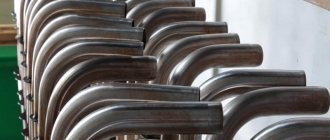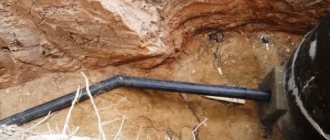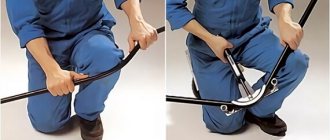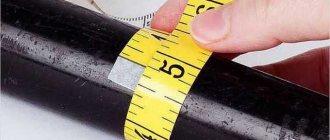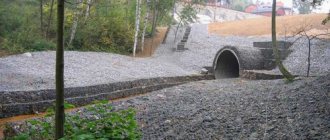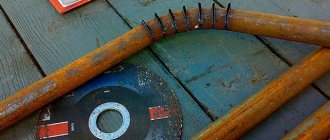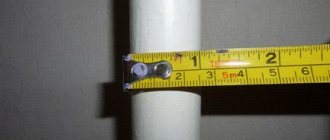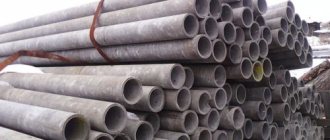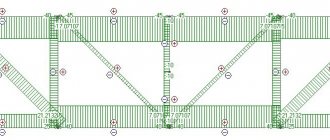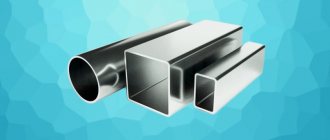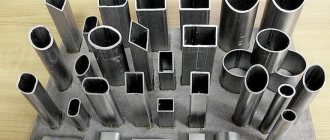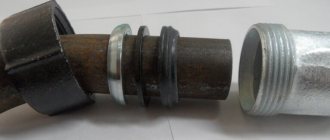Bending a metal pipe is often a labor-intensive task that requires skill and knowledge, as well as special tools. It is especially difficult to make curved parts from thin-walled pipes and some types of profile pipes. A curved pipe at a private construction site, in a house, in a country house and in everyday life is needed not only for the installation and repair of internal pipelines, but also for various crafts, for repairing, strengthening structures and components of outbuildings, for small forms of landscape - it is difficult to list all the areas where curved pipe parts are required.
Pipe bending radius
The bending radius of a pipe of a specific diameter and material is a calculated and standardized value, and even experienced craftsmen do not consider it shameful to look into the technical documentation and GOST.
Minimum pipe bending radius
When bending a metal pipe, the elasticity of the material is noticeable - the metal tends to return to its original shape after removing the load, so the bending angle is needed more than the design one (by several degrees), which is done experimentally in private construction conditions. The permissible pipe bending radius is the key to safe and reliable operation of pipeline systems; and even when constructing a garden greenhouse on a frame made of pipes, it is necessary to take into account the material and cross-section of the pipe and maintain a minimum radius tolerance.
Pipe bending methods and their advantages
Pipe bending is a technology where the desired rotation in the direction of the pipeline line is created by physical impact on the workpiece, the method has the following advantages:
- Reduced metal consumption; there are no adapter flanges, couplings or pipes in the line.
- Reduced labor costs when installing pipelines compared to welded joints.
- Low hydraulic losses due to unchanged profile section.
Rice. 3 Mandrels for pipe benders
- Unchangeable structure of the metal, its physical and chemical parameters compared to welding.
- High quality sealing, the line has a uniform structure without breaks or joints.
- Aesthetic appearance of the highway
There are two main bending technologies - hot and cold, devices and methods can be divided into the following categories:
- According to the type of physical impact, the pipe bending unit can be manual or electric with a mechanical or hydraulic drive.
- By bending technology - mandrel (bent using special internal protectors), mandrelless, and rolling installations with rollers.
- By profile - installations for metal profile rectangular or round products.
Rice. 4 Hot pipe bending methods
Hot bending
This technology, popular in everyday life, is used in cases where there is no pipe bending machine or it is not possible to carry out work using a cold method; the process consists of several operations:
- The workpiece is filled with fine-grained river sand without foreign inclusions in dry form. To do this, insert a plug at one end, fill it with sand and close the hole on the other side.
- The bending point is heated to a temperature of no more than 900 degrees to avoid burnout, and the part is gradually smoothly mechanically wound around a round template.
- At the end of the process, the plugs are removed and sand is poured out of the workpiece.
Bending a profile pipe
It is not easy to bend a profile pipe, but private builders and summer residents do not give in to such tasks. A bent metal part from a square or other pipe may be needed for a greenhouse or small forms, to strengthen outbuildings and other purposes. Of course, we are not talking about aluminum profiles, which can be bent into a ring without much effort, but about a durable “structural” pipe. Bending of rough various profiles is required either with partial bending or with full bending - up to 90 degrees. This type of bending requires not only pressure, but sometimes also heat. Profile pipes are very rigid, and when bending, the pipe will work simultaneously in compression (along the inside of the profile) and tension (on the outside of the bend).
It makes sense to bend a profile pipe if it has a wall no thinner than 2 mm. Even with good skill and the presence of a branded pipe bender, the stretched pipe wall will turn out to be too thin and fragile. For such profiles, welds are preferred. Before bending a pipe, you need to make sure that the metal is suitable for this purpose, and also accurately determine the profile and bending parameters: wall thickness, type of section, minimum bend radius, and select equipment based on these data. Manual bending is not possible for all types of pipes.
Multidirectional forces can cause a number of problems when bending a profile:
- Folds may form along the inside of the fold;
- The outer part of the wall after bending is greatly stretched and the metal may not be able to withstand it, the pipe will burst at the bend or lose strength (yield strength);
- The alignment of pipe parts is always disrupted when bending manually or with a pipe bender, since it is impossible to achieve the same and uniform change in the shape of all sections of the pipe.
Profile pipes of large diameters are usually bent using a pipe bender (classically this is a simple device of a drive wheel on a support; pipe benders are often made by hand to the desired pipe diameter). A branded pipe bender can be manual (with a wheel and a handle for rotation, optimal for thin pipes), and electric – for large volumes of work and large cross-section pipes. They also bend metal pipes of various sections without a pipe bender, manually using manufactured springs (wire thickness from 2 mm), a grinder, a welding machine, or using heating over an open fire (the bending area is filled with river sand). This kind of work cannot be done in a residential area, but in a country house or private area it is quite possible, especially in a workshop where there is a vice and a workbench. Craftsmen bend pipes using a regular gas canister and a clamping device with a template.
A section of pipe is heated to increase the plasticity of the metal; the length of the section is approximately 6 pipe diameters. They work in such a way that there are as few heating-cooling cycles as possible, so that heating does not lead to increased brittleness of the pipe metal. Large cross-section profiles are bent using a grinder, making cuts across the pipe according to the markings - three or more cuts, which are welded after bending. The seams can be sanded - for parts that require aesthetics, this is the best option, folds do not appear, strength is not lost and the bend will not become a weak link in the design of a pergola, gazebo, and so on. The curve will look smooth; not round, but “stepped”, but this is not so important.
A few more proven life hacks for manual pipe bending:
- Welded pipes are always bent with the seam facing outward - inside the bend, the metal experiences greater stress and the seam may come apart.
- A pipe made of non-ferrous metal and a material that is absolutely resistant to corrosion is bent with frozen water: water is poured into the pipe and the entire part is frozen, so the bend will be both durable and aesthetic.
e = . 100, w
where Dmox is the maximum diameter at the bending point, mm;
В min — minimum diameter at the bending point, mm;
IN NO. — nominal diameter at the bending point, mm.
The percentage thinning of the minimum pipe wall thickness (&) is calculated using the formula,
where is the wall thickness along the outer part of the bend, mm;
Shom—nominal wall thickness, mm.
Berezovka. Printing house. Zzk. hi 37-3000
|Ish. N" mean. 1_Signature and dago >In return. ina. Ht Ii.” Ht dubya. Signature and date
Permissible deviations when bending pipes according to the ovality of the cross-section are given in table. 5, according to thinning in table. IN.
Section ovality, %, no more
Nominal wall thickness, mm
Allowable wall thinning in relation to the nominal thickness,%> no more
Note: The reduction in the nominal wall thickness at the bending site should not exceed the sum of the tolerances: minus tolerance according to the standards specified in the introductory part, and thinning during bending - according to Table 6.
2.4. In places where pipes are bent, corrugations are allowed in height, mm, no more than:
2 - for pipe diameters up to 25 mm;
3 - with a pipe diameter of 25-60 w;
4 - with a pipe diameter of 60-100 mm:
5 - with a sales pipe diameter of 100 mm.
2.5. Cracks, stains, flaws, sinkholes and sunsets are not allowed on the surface of the pipes.
Bending a metal-plastic pipe
The most popular pipes for heating and plumbing inside the house: you can work with metal-plastic pipes even at home. There are a lot of twists and turns in the interior, so the technology has already been sufficiently worked out by craftsmen and is not very complicated. The only mistake is to try to give the pipe a complex shape without taking into account the fragility of metal-plastic; this can lead to deformation, brittle fracture and damage to the material. There are several ways to bend a metal-plastic pipe:
- A simple manual method, not very reliable: without tools, literally with your hands, carefully give the pipe the desired bend. For a tube of small diameter (up to 20 mm), this can be done, but whether the structure of the material is not damaged in this case is a complex question; further operation will show.
- If the MP pipe has medium hardness, then it can be bent with a spring. This spring is special, tailored to the diameter of the pipe and made of strong wire, and a cable is attached to the end of the spring, otherwise it will be very difficult to remove the spring from the finished part with a bend. To bend the pipe as needed, you must place the spring exactly in the center (the middle of the spring and the center of the bend must coincide). The work requires skill; bending the tube very smoothly and without excessive force with your hands; you can use a stop.
- You can bend a pipe with wire rods. Pieces of strong wire are placed in the future bend of the pipe to create a frame for more even distribution of forces. With wire, the tube will bend more smoothly and will not break. The “frame” should be removed from the fold carefully, and always completely.
- With sand or salt - it is difficult, labor-intensive, and requires a workshop. Fine, clean sifted sand (salt) is poured into the tube and plugs are installed; there should be no voids left, otherwise there will be thermal deformation of the pipe. To heat the pipe, use a gas canister, a blowtorch, etc. the heated metal polymer acquires plasticity and, with skill, the pipe can be bent cleanly, without destruction or deformation. The sand in the pipe heats up very quickly, and should not overheat the material; you can simply check: paper applied to the heating area darkens, but does not light up.
But the simplest and best way is with the help of a pipe bender, and if the amount of work is large, then it is better to forget about manual bending of MP pipes. A manual or hydraulic pipe bender will also come in handy in the future for repairs of various pipe products.
GOST 17365-71; Cold Forming Handbook
Source: GOST 17365-71; Cold Forming Handbook
The minimum pipe bending radii R must be:
- for pipes with an outer diameter of up to 20 mm, not less than...2.5D
- for pipes with an outer diameter over 20 mm, not less than...3.5D (where D is the outer diameter of the pipe).
The thinning of the walls in places where pipes bend and where curved sections transition into straight ones should not exceed:
- for steel pipes – 20% of the original wall thickness
- for aluminum alloy pipes – 25% of the original wall thickness.
